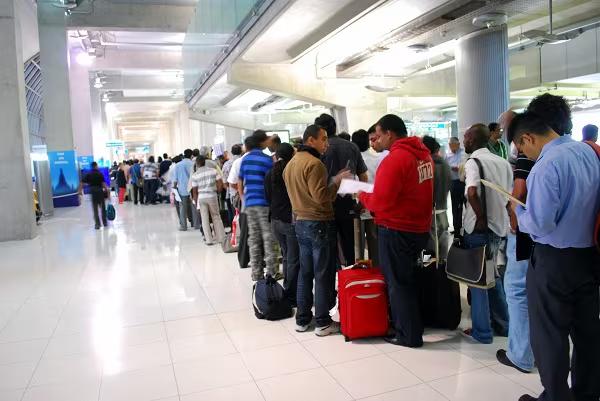
Border reopening leads to rapid migration increase
Since New Zealand’s borders fully reopened in July last year, net migration has turned strongly positive. The net inflow of people in the three months to October 2022 was 8,558 people, representing the biggest net inflow since early 2020 when the COVID-19 pandemic began.
Arrivals of non-NZ citizens have recovered from 33% of pre-pandemic (2018) levels in the three months to April 2022 to 89% of pre-pandemic levels in the three months to October. Partly offsetting this lift in arrivals is the fact that departures of both NZ and non-NZ citizens are above 2018 levels, and NZ citizen arrivals are languishing at just 76% of pre-pandemic levels. Nevertheless, the dramatic recovery in foreign arrivals points towards higher net migration and stronger population growth in 2023 and 2024 than we had previously been forecasting. After a surge in Kiwi departure numbers in late 2021 and early 2022, they have also not kept increasing at the rate we had anticipated.
Although Chart 1 suggests there is still a lot of recovery in foreign arrivals before we are back to “normal” pre-COVID levels, it’s important to note that the figures are annual flows. If the flows of the last three months are sustained throughout 2023, net migration could easily be pushing towards 30,000pa by the end of this year.
Probably not enough to stabilise housing
A higher outlook for net migration spells potential good news for the construction industry, with stronger population growth implying that underlying demand for new homes is likely to be better over the next couple of years than our previous modelling had suggested. However, even with recent data from CoreLogic suggesting that the rate of decline in house prices might be starting to moderate, it’s probably too early to be getting upbeat abut the housing market’s prospects. Further substantial increases in the official cash rate by mid-2023 will undermine the ability of potential buyers to service a mortgage and are likely to dominate the effects of any lift in net migration in the near term. We expect mortgage rates, at their highest levels in 15 years, to maintain downward pressure on house prices throughout the rest of this year.
Evidence of greater inflows of foreign citizens is also good news for businesses struggling with a lack of capacity in the labour market. For example, anyone who’s been away on a break during the summer holiday cannot fail to have noticed the shortages of workers in the hospitality, retail, and tourism industries. The government’s expanding Green List of approved occupations points towards an ever more pragmatic approach to immigration than the “reset” that was announced in May 2021, and it now seems almost inevitable that foreign arrivals will track back towards pre-COVID levels throughout this year. The only caveat to that assessment is New Zealand’s weakening labour market, which could limit the willingness and ability of foreigners to come here and readily find work.
More construction workers arriving
The pick-up in foreign arrivals is also showing through in arrivals of construction and related workers from overseas. In September and October, the number of arrivals across selected construction occupations1 totalled 1,365 people, or 14% of total arrivals.2 Both figures are the highest for any two-month period on record (with data going back to 2009). Even in 2018, when arrivals across these occupations were at their peak, they only made up 12% of total arrivals.
Chart 2 shows the emerging recovery in the annual inflow of construction-related workers.
The inclusion of several construction roles on the government’s immigration Green List appears to be facilitating the acceleration in arrivals of construction workers. Although arrivals might not be sustained at the rate of this initial rush as the borders have reopened, the early trend augers well for some easing of labour capacity constraints within the construction industry in coming months.
The growth in arrivals comes at the same time as Monthly Employment Indicators for November showed a softening in construction job growth to 2.5%pa, its weakest since this detailed data became available in the first half of 2020. It’s difficult to know how much of this slowdown is due to a limited supply of workers, and how much might be due to expectations of weaker activity levels heading into 2023. However, there must now be an emerging risk of an oversupply of workers, particularly in the residential subindustry, if the pipeline of consented activity starts to evaporate and demand for work falls away sharply.
The squeeze from closed borders during the pandemic
Infometrics analysis of Migrant Employment Data from the Ministry of Business, Innovation and Employment demonstrates the squeeze that COVID-19 and the border closures have placed on the labour supply in the construction industry over the last three years. Although the number of Kiwis working in the industry has increased by almost 4,500 more people between 2019 and 2022 than it did between 2016 and 2019, Chart 3 shows that, unsurprisingly, there has been almost no increase in the number of foreigners.3
The squeeze is even more stark if we concentrate on Auckland data. Prior to the pandemic, Auckland had been disproportionately reliant on workers from overseas, representing three quarters of the increase in job numbers for non-NZ citizens between 2016 and 2019. Chart 4 shows how much this source of construction workers for Auckland dried up during COVID-19. The labour supply issues were exacerbated by the region’s struggles to retain Kiwis as well in the face of highly unaffordable housing and more prolonged lockdown restrictions during 2021.
A looming oversupply, or just reduced capacity constraints?
In summary, an increasing number of foreign workers throughout 2023 looks set to take place at the same time as demand for those workers potentially starts to ease. Nevertheless, given how stretched capacity has been for construction in particular, greater access to workers is still likely to be welcomed by employers in the industry.
It’s also worth remembering that the expected downturn in construction activity is mostly limited to the residential subindustry, with solid levels of non-residential work and persistent pressures for more infrastructure investment to take place. Bearing in mind some of the highly specialised roles in civil construction that are almost impossible to fill from the domestic workforce, the rapid recovery in immigration makes us hopeful that some of the capacity bottlenecks and skill shortages in the industry will become significantly less critical throughout 2023 and 2024.
1 Construction, production, and distribution managers; architects, designers, planners, and surveyors; building and engineering technicians; bricklayers, carpenters, and joiners; floor finishers and painting trades workers; glaziers, plasterers, and tilers; plumbers; electricians; and construction and mining labourers.
2 Excluding responses that were unidentifiable, outside scope, or not stated.
3 Care needs to be taken when interpreting the changes in the number of people on work visas. Our interpretation of the data is that a substantial number of people will have recently moved out of work visa categories and into the recent resident category as the special 2021 Resident Visa applications have been processed, and we have assumed that 2021 Resident Visas are being classed as “Recent Residents – Skilled”. Even so, the total number of additional foreigners in the construction workforce has not increased anywhere near as much over the last three years as it did over the previous three years.






























